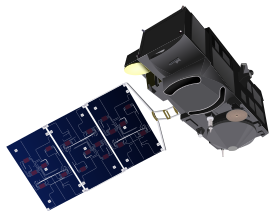 | |||
| Manufacturer | Thales Alenia Space[1] | ||
|---|---|---|---|
| Operator | EUMETSAT | ||
| Applications | Earth observation | ||
| Specifications | |||
| Spacecraft type | Satellite | ||
| Bus | Prima | ||
| Series | 2 | ||
| Launch mass | 1,250 kg (2,756 lb)[2] | ||
| Dimensions | 3.710 × 2.202 × 2.207 m (12.2 × 7.2 × 7.2 ft)[2] | ||
| Power | 2,100 W[2] | ||
| Design life | 7 years[2] | ||
| Production | |||
| Status | Active | ||
| On order | 2[3] | ||
| Built | 3 | ||
| Launched | 2 | ||
| Operational | 2 | ||
| Maiden launch | Sentinel-3A 16 February 2016 | ||
| Last launch | Sentinel-3B 25 April 2018 | ||
| |||
Sentinel-3 is an Earth observation heavy satellite series developed by the European Space Agency as part of the Copernicus Programme.[4][5][6] As of 2024, it consists of 2 satellites: Sentinel-3A and Sentinel-3B. After initial commissioning, each satellite was handed over to EUMETSAT for the routine operations phase of the mission. Two recurrent satellites, Sentinel-3C and Sentinel-3D, will follow in approximately 2025 and 2028 respectively to ensure continuity of the Sentinel-3 mission.[7]
Each Sentinel-3 satellite is designed to operate for seven years in a sun-synchronous low-Earth orbit. The satellites use multiple sensors to measure topography, temperature, marine ecosystems, water quality, pollution, and other features for ocean forecasting and environmental monitoring.
- ^ "Copernicus: Sentinel-3". eoPortal. European Space Agency. Retrieved 21 December 2015.
- ^ a b c d "Sentinel-3 Data Sheet" (PDF). European Space Agency. August 2013. Retrieved 17 November 2016.
- ^ Henry, Caleb (10 February 2016). "ESA Awards Sentinel 3C and D Satellite Contracts to Thales Alenia Space". Via Satellite. Retrieved 17 November 2016.
- ^ "Sentinel 3". European Space Agency. 2015. Archived from the original on 9 June 2016. Retrieved 10 June 2015.
- ^ Donlon, C.; Berruti, B.; Buongiorno, A; Ferreira, M-H; Femenias, P.; et al. (2012). "The Global Monitoring for Environment and Security (GMES) Sentinel-3 Mission". Remote Sensing of Environment. 120: 27–57. Bibcode:2012RSEnv.120...37D. doi:10.1016/j.rse.2011.07.024.
- ^ "Copernicus: Sentinel-3". European Space Agency. 2015. Retrieved 11 June 2015.
- ^ "Planned launches". EUMETSAT. Retrieved 14 December 2023.